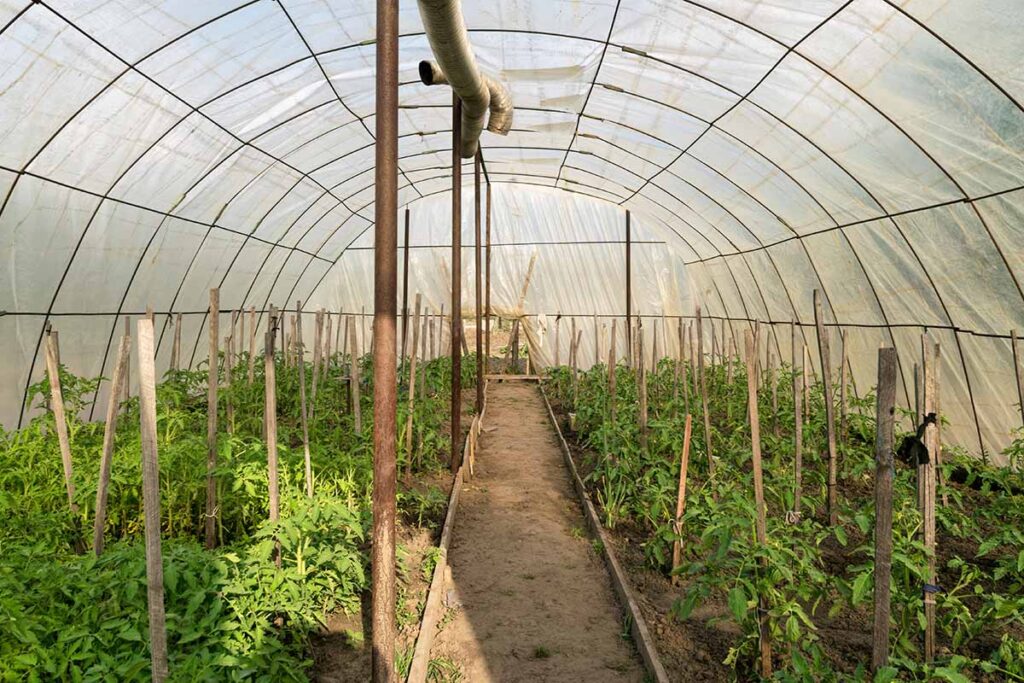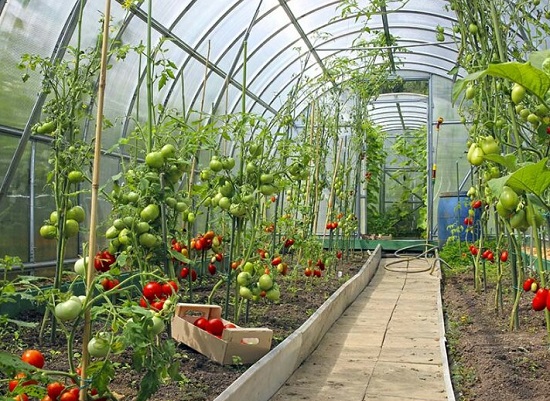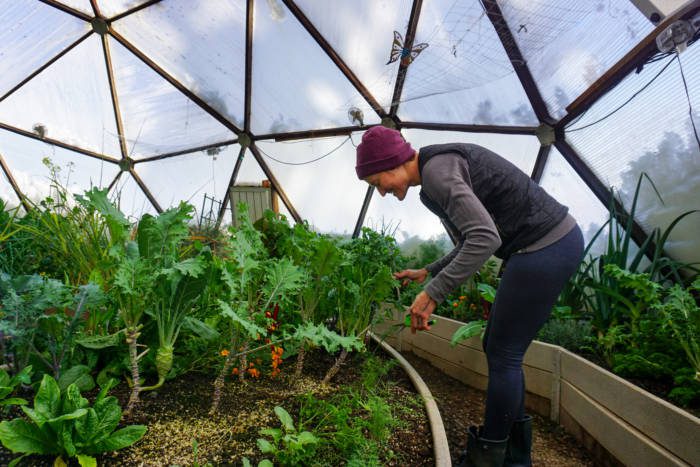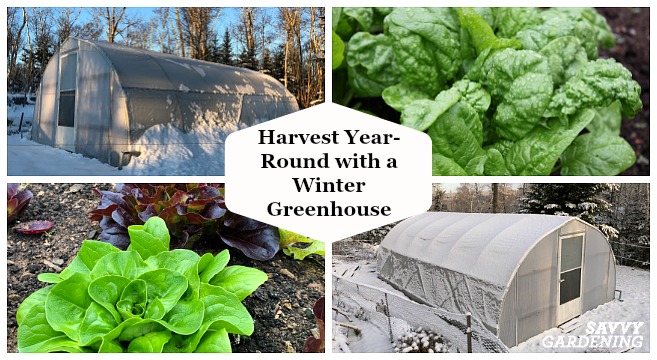
Imagine the possibility of having fresh, homegrown produce all year long, regardless of the weather outside. With a greenhouse, this dream can become a reality. Whether you’re a seasoned gardener looking to extend your growing season or a beginner eager to learn, using a greenhouse for year-round planting opens up a world of possibilities. The controlled environment of a greenhouse provides the perfect conditions for nurturing plants, protecting them from harsh elements and allowing them to thrive. In this article, we will explore the benefits and tips for using a greenhouse throughout the year, showcasing how this ingenious structure can transform your gardening experience.
Choosing the Right Greenhouse
Considering the Climate
When choosing a greenhouse, one of the most important factors to consider is the climate in your area. Different climates require different types of greenhouses to ensure optimal conditions for year-round planting. For example, if you live in a colder climate with harsh winters, you may need a greenhouse with better insulation and heating capabilities. On the other hand, if you live in a hot and humid climate, you will need a greenhouse that provides adequate ventilation and shade. By taking into account the local climate, you can select a greenhouse that is best suited for your specific needs.
Determining the Size
The size of your greenhouse will depend on the available space in your backyard or property, as well as your planting goals. Consider the number of plants you want to grow and the space required for each plant to thrive. Additionally, think about your long-term plans and whether you may want to expand your greenhouse in the future. It’s always a good idea to choose a slightly larger greenhouse than what you think you will initially need, as this will allow for more flexibility and room to grow.
Selecting the Material
Greenhouses can be constructed from various materials, each with its own advantages and disadvantages. Common materials include glass, polycarbonate, and polyethylene. Glass provides excellent light transmission and durability, but it is expensive and heavy. Polycarbonate is a lightweight and shatterproof option that offers good insulation, but it can degrade over time. Polyethylene is a cost-effective choice that provides good insulation and light diffusion, but it may need to be replaced more frequently. Consider your budget, climate, and specific requirements when selecting the material for your greenhouse.
Assessing the Budget
Before purchasing a greenhouse, it’s important to determine your budget and assess the overall costs involved. In addition to the cost of the greenhouse structure itself, consider expenses such as heating and cooling systems, ventilation equipment, lighting, and other necessary accessories. It’s also important to factor in ongoing maintenance costs and potential repairs. By carefully assessing your budget, you can make an informed decision and choose a greenhouse that meets your needs without breaking the bank.
Understanding Year-Round Planting
Benefits of Year-Round Planting
Engaging in year-round planting in a greenhouse offers numerous benefits. One of the biggest advantages is the ability to extend the growing season, allowing you to harvest fresh produce even in the winter months. This not only provides you with a constant supply of healthy and nutritious food but also helps you save money on grocery bills. Year-round planting also allows for greater control over growing conditions, such as temperature, humidity, and light, resulting in healthier and more vigorous plants. Additionally, growing plants year-round can be a therapeutic and enjoyable hobby that brings a sense of fulfillment and satisfaction.
Types of Plants for Year-Round Planting
When engaging in year-round planting, it’s important to choose plants that are suitable for the specific season and growing conditions in your greenhouse. Cold-hardy plants, such as kale, spinach, and carrots, are excellent choices for winter planting. For the warmer months, consider growing tomatoes, peppers, cucumbers, and other warm-season crops. Perennial plants, such as herbs and flowering plants, can provide a constant source of beauty and aroma throughout the year. Additionally, microgreens and herbs are perfect for year-round planting as they have a quick turnaround and can be harvested multiple times.
Challenges of Year-Round Planting
While year-round planting in a greenhouse is advantageous, it does come with its own set of challenges. One of the main challenges is maintaining consistent and optimal growing conditions throughout the year, especially during extreme weather conditions. It requires careful monitoring of temperature, humidity, and light levels to ensure the plants are receiving the ideal conditions for growth. Pests and diseases can also pose a challenge, as the controlled environment of a greenhouse can create favorable conditions for their development. Proper pest and disease management techniques are essential to overcome these challenges and maintain healthy plants.
Essential Factors for Successful Year-Round Planting
To ensure successful year-round planting in your greenhouse, certain factors need to be taken into consideration. Temperature control is crucial, as different plants have specific temperature requirements. Proper heating and cooling systems should be in place to maintain the desired temperature range. Adequate ventilation and air circulation are also important for preventing mold, mildew, and diseases. Lighting requirements should be met to compensate for reduced natural sunlight during the winter months. Regular watering and humidity control are essential for preventing drought stress and maintaining appropriate moisture levels. Finally, pest and disease prevention measures, such as regular monitoring, proper sanitation, and organic pest control methods, are vital for a thriving greenhouse garden.

This image is property of gardenerspath.com.
Preparing the Greenhouse for Year-Round Planting
Insulation and Heating
To prepare your greenhouse for year-round planting, it’s important to ensure proper insulation and heating. Insulating your greenhouse helps to retain heat during colder months and prevent excessive heat buildup in the summer. This can be achieved through double-layered or insulated glazing, as well as using insulating materials on walls, floors, and ceilings. Heating systems, such as electric heaters or propane heaters, should be installed to maintain the desired temperature range. Thermostats and temperature sensors can be used to automate the heating process and ensure consistent conditions for plant growth.
Ventilation and Air Circulation
Good ventilation and air circulation are vital for a healthy greenhouse environment. Proper airflow helps to control temperature, humidity, and carbon dioxide levels, as well as prevent the buildup of fungal spores, mold, and pests. Ventilation can be achieved through the use of windows, vents, fans, and exhaust systems. Automatic vents and fans can be controlled by temperature or humidity sensors for optimal air circulation. It’s important to strike a balance between providing enough ventilation to prevent issues like heat stress and providing adequate insulation to retain heat during colder periods.
Lighting Requirements
In a greenhouse, the amount and quality of natural sunlight may not always be sufficient for year-round plant growth. Supplemental lighting can be used to provide the required spectrum and intensity of light for optimal plant growth. High-intensity discharge (HID) lamps, fluorescent lights, and LED grow lights are commonly used for greenhouse lighting. The lighting duration and intensity should be adjusted according to specific plant needs, growth stages, and seasonal changes. Investing in a timer or automated lighting system can simplify the process and ensure consistent and efficient use of artificial lighting.
Watering and Humidity Control
Proper watering and humidity control are essential for successful year-round planting. Greenhouse plants require a consistent supply of water, as they cannot rely on rainfall like outdoor plants. Drip irrigation systems, soaker hoses, or misting systems can be used to efficiently water plants and minimize water waste. Automatic irrigation timers and controllers can help maintain regular watering schedules. Humidity control is equally important, as excessive moisture can lead to plant diseases, while low humidity can cause wilting and stress. Effective methods for humidity control include the use of humidifiers, dehumidifiers, and proper air circulation.
Pest and Disease Prevention
Preventing pests and diseases is crucial for maintaining healthy plants in a greenhouse. The controlled environment of a greenhouse can unintentionally create favorable conditions for pests and diseases to thrive. Regular monitoring and inspection are essential to detect any signs of infestation or disease outbreak early on. Implementing integrated pest management (IPM) strategies, such as physical barriers, beneficial insects, and organic pest control methods, can help keep pests in check without relying on harmful chemicals. Proper sanitation practices, regular cleaning of tools and equipment, and crop rotation can also help prevent the spread of diseases.
Choosing the Right Plants for Year-Round Planting
Cold-Hardy Plants
Cold-hardy plants are ideal for year-round planting, especially in winter. These plants are adapted to survive and even thrive in low temperatures. Some excellent cold-hardy vegetables and herbs include kale, spinach, lettuce, Swiss chard, arugula, parsley, and thyme. Cold-tolerant flowering plants, such as pansies and violas, can add color and beauty to your greenhouse during the colder months. It’s important to select varieties specifically bred for cold climates to ensure better success.
Warm-Season Crops
For the warmer months, warm-season crops are perfect for year-round planting in a greenhouse. These plants require higher temperatures and longer daylight hours to grow and produce. Tomatoes, peppers, cucumbers, zucchini, eggplants, and beans are popular choices for greenhouse cultivation. Some crops, such as tomatoes, may require trellising or staking for proper growth and support. Selecting heat-tolerant varieties and providing adequate ventilation and shading during hot periods are essential for success with warm-season crops.
Perennial Plants
Perennial plants are an excellent addition to a greenhouse garden, as they provide year-round beauty and sometimes edible harvests. Some common perennial plants suitable for greenhouse cultivation include herbs like rosemary, oregano, thyme, and mint. Flowers like geraniums, begonias, and lavender also thrive in a greenhouse environment. With proper care and pruning, perennial plants can last for many years and continue to add color, fragrance, and foliage to your greenhouse.
Herbs and Microgreens
Herbs and microgreens are perfect for year-round planting in a greenhouse due to their compact size and fast growth cycle. Herbs like basil, cilantro, dill, and sage can be harvested multiple times throughout the year and add fresh flavors to your meals. Microgreens, such as arugula, radish, broccoli, and kale, are nutrient-packed and can be harvested just a few weeks after planting. Their quick turnaround time makes them an ideal choice for continuous harvest throughout the year.

This image is property of ogden_images.s3.amazonaws.com.
Scheduling and Rotating Crops
Planning Planting Dates
To ensure a continuous supply of fresh produce, planning planting dates is crucial. Depending on the specific crops and their growth requirements, make a schedule for sowing seeds or transplanting seedlings. Take into account the average time it takes for each crop to reach maturity and factor in any adjustments needed for greenhouse conditions. Some crops may require starting seeds indoors or using grow lights to provide adequate light during the early stages of growth. A planting schedule will help you stay organized and ensure a steady flow of harvest throughout the year.
Succession Planting
Succession planting involves planting new crops in succession, as soon as previous crops are harvested. This technique maximizes the use of available space and ensures a continuous supply of fresh produce. As you harvest one crop, replant with another that can thrive in the current season. For example, after harvesting lettuce, replant with kale or spinach for winter production. Succession planting allows you to capitalize on the growing conditions in your greenhouse and make the most of your available growing space.
Crop Rotation
Crop rotation is an important practice in greenhouse gardening to minimize the risk of disease and nutrient imbalances. Rotating crops involves changing the location of different plant families each growing season. This helps prevent the buildup of pests and diseases that may be specific to certain crops. It also prevents the depletion of soil nutrients, as different plant families have different nutrient requirements. Rotating between warm-season and cool-season crops can provide a more balanced and sustainable growing environment in your greenhouse.
Tools and Equipment for Year-Round Planting
Essential Gardening Tools
Having the right gardening tools is essential for successful year-round planting. Basic tools, such as a trowel, hand pruners, and a garden fork, are necessary for various gardening tasks. A sturdy garden hose or watering can will make watering plants easier. Additionally, a garden rake or hoe can help with soil preparation and weed control. Depending on your greenhouse setup, you may also need a ladder or step stool to reach hanging plants or high shelves. Having a well-equipped toolbox will make your gardening tasks more efficient and enjoyable.
Potting and Planting Equipment
Potting and planting equipment is crucial for working with container plants in a greenhouse. High-quality potting soil, containers, and trays are essential for starting seeds and growing plants. A potting bench or table provides a dedicated area for potting and transplanting activities. Transplanting tools, such as a transplanting trowel or dibber, help with careful handling of seedlings. If you plan to grow vining crops, trellises or stakes may be needed for proper support and training.
Monitoring and Control Systems
To maintain optimal growing conditions in your greenhouse, monitoring and control systems can be highly beneficial. Thermometers and hygrometers are essential for monitoring temperature and humidity levels. An automatic temperature controller can be used to regulate heating and cooling systems based on preset parameters. A moisture sensor or soil moisture meter can help ensure proper watering and prevent over or under-watering. Additionally, a light meter can help assess the amount and intensity of light reaching your plants. Incorporating these monitoring and control systems will allow for more precise and efficient management of your greenhouse environment.

This image is property of growingspaces.com.
Caring for Plants in a Greenhouse
Watering and Fertilizing
Proper watering and fertilizing practices are essential for the health and vigor of your greenhouse plants. Water greenhouse plants regularly, ensuring that the soil is evenly moist but not waterlogged. The frequency of watering will depend on the specific plant and its moisture requirements. Applying a well-balanced organic fertilizer or compost can provide the necessary nutrients for healthy growth. Follow the recommended application rates and schedules for each type of plant. Monitoring soil moisture levels and using water-soluble fertilizers can help ensure accurate and targeted application.
Pruning and Training
Pruning and training are important techniques for shaping and maintaining plants in a greenhouse. Regular pruning helps remove dead or diseased plant parts, improves air circulation, and prevents overcrowding. It also encourages bushier growth and better fruit production. Training involves guiding the growth of plants to maximize space and light availability. This can be done through techniques like trellising, staking, and pinching. Pruning and training should be done with sharp and clean tools to avoid the spread of diseases.
Pest and Disease Management
Preventing and managing pests and diseases are essential for maintaining healthy plants in a greenhouse. Regularly inspect plants for signs of pests like aphids, whiteflies, or spider mites. Implement integrated pest management (IPM) strategies, such as introducing beneficial insects or using organic pest control methods, before resorting to chemical pesticides. Similarly, monitor plants for any signs of diseases such as powdery mildew or fungal infections. Promptly remove and destroy affected plant parts to minimize the spread. Cultivating disease-resistant plant varieties and maintaining proper sanitation practices are also effective preventive measures.
Harvesting and Storage
Harvesting your greenhouse-grown produce at the right time is important for the best flavor and nutritional value. Follow the recommended harvesting guidelines for each crop and pick fruits or vegetables when they are ripe. Store harvested produce properly to maintain freshness and prevent spoilage. Some crops can be stored at room temperature, while others may require refrigeration. Consider canning or preserving excess harvests to enjoy your greenhouse produce throughout the year. Properly labeled containers or storage bags will help you organize and keep track of your harvested goods.
Environmental Considerations
Energy Efficiency
Greenhouse gardening requires energy inputs for heating, cooling, lighting, and other operations. To minimize energy consumption and reduce environmental impact, it’s important to prioritize energy-efficient practices. Insulating the greenhouse structure, using energy-efficient glazing materials, and sealing any air leaks can help conserve heat. Utilizing natural daylight whenever possible and supplementing with energy-efficient lighting systems can reduce electricity usage. Incorporating renewable energy sources, such as solar panels, can further decrease energy reliance and promote a greener greenhouse operation.
Water Conservation
Water is a precious resource, and conserving water is essential in greenhouse gardening. Using water-efficient irrigation systems, such as drip irrigation or soaker hoses, can minimize water waste. Collecting rainwater in barrels or tanks during the rainy season can provide a sustainable water source for irrigation. Monitoring soil moisture levels and using moisture sensors can prevent overwatering. Investing in water-saving technologies, like water-saving nozzles and timers, can also help in reducing water usage. Responsible water management in the greenhouse ensures a more sustainable and eco-friendly approach to gardening.
Sustainable Practices
Adopting sustainable practices in your greenhouse can contribute to a more environmentally friendly gardening experience. Consider using organic and natural gardening methods to minimize reliance on synthetic chemicals. Implementing composting systems and utilizing organic fertilizers can help improve soil health and promote sustainable nutrient cycling. Introducing beneficial insects for pest control instead of chemical pesticides can maintain a balanced ecosystem within the greenhouse. Using recycled and biodegradable materials for containers, pots, and plant labels can reduce waste. By embracing sustainable practices, you can create a green and eco-conscious greenhouse garden.

This image is property of i0.wp.com.
Common Challenges and Troubleshooting
Temperature Fluctuations
Temperature fluctuations can pose challenges in a greenhouse, impacting plant growth and health. Fluctuating temperatures can result from inadequate insulation, poor ventilation, or improper heating and cooling systems. To address this, ensure your greenhouse is well-insulated and sealed to minimize temperature fluctuations. Regularly monitor and adjust heating and cooling systems based on temperature changes. Providing proper ventilation and air circulation can help mitigate extreme temperature variations and maintain a more stable growing environment.
Pest Infestations
Pests can find their way into your greenhouse and cause damage to your plants. Aphids, mealybugs, spider mites, and other common greenhouse pests can quickly multiply and infest your plants if left unchecked. Regularly inspect your plants for any signs of infestation, such as sticky residues, distorted growth, or visible pests. Introduce beneficial insects, such as ladybugs or predatory mites, to help control pest populations naturally. If necessary, employ organic pest control methods such as neem oil, insecticidal soaps, or horticultural oils. Early detection and intervention are key to preventing severe pest outbreaks and minimizing plant damage.
Disease Outbreaks
Diseases can also pose a threat to your greenhouse plants, especially in the controlled environment. Fungal, bacterial, or viral diseases can spread quickly and weaken or kill your plants. Proper sanitation practices, such as cleaning tools and equipment, disinfecting pots, and removing dead plant material, can help prevent disease spread. Avoid overhead watering, as wet foliage can create a favorable environment for diseases. Crop rotation and choosing disease-resistant plant varieties can also reduce the risk of disease outbreaks. If necessary, treat affected plants with approved organic fungicides or biopesticides to control diseases.
Nutrient Imbalances
Maintaining proper nutrient balance is essential for healthy plant growth. Over- or under-fertilization can lead to nutrient imbalances, affecting plant health and productivity. Regularly monitor the nutrient levels in your greenhouse soil and adjust fertilization accordingly. Conduct soil tests to determine any deficiencies or excesses of specific nutrients and apply appropriate organic fertilizers to correct imbalances. Using organic matter, such as compost or well-rotted manure, can help improve soil structure and enhance nutrient availability. Incorporating organic slow-release fertilizers can provide a more consistent and steady nutrient supply for your plants.
Cost and Return on Investment
Initial Investment
Setting up a greenhouse for year-round planting involves an initial investment. This includes the cost of the greenhouse structure itself, any necessary permits, and site preparation. The type and size of the greenhouse, as well as the materials used, can greatly influence the initial cost. Additional expenses may include heating and cooling systems, lighting equipment, irrigation systems, and other necessary accessories. It’s important to carefully assess your budget and prioritize your needs to make cost-effective choices during the initial setup.
Operating Costs
Operating costs for a greenhouse depend on various factors, including the energy requirements for heating and cooling, water usage, and ongoing maintenance. Energy costs can be reduced by implementing energy-efficient practices, such as proper insulation, efficient heating systems, and smart use of artificial lighting. Water costs can be minimized through water conservation techniques like rainwater harvesting and using efficient irrigation systems. Regular maintenance and repairs may incur additional costs, so budgeting for these expenses is important.
Economic Benefits
While greenhouse gardening does come with initial and ongoing costs, there are economic benefits to consider. By growing your own produce year-round, you can save money on grocery bills and have a constant supply of fresh, organic, and high-quality produce. This can significantly cut down your food expenses and contribute to a healthier lifestyle. Additionally, greenhouse gardening offers the opportunity for small-scale commercial ventures, such as selling excess harvests or starting a CSA (Community Supported Agriculture) program. By turning your greenhouse into a source of income, you can potentially offset the initial investment and generate additional revenue.
In conclusion, using a greenhouse for year-round planting offers numerous advantages and opportunities. By selecting the right greenhouse, understanding the requirements of year-round planting, preparing the greenhouse for optimal conditions, choosing suitable plants, implementing proper care and maintenance practices, and considering environmental and economic factors, you can create a thriving and sustainable greenhouse garden. With dedication, knowledge, and the right tools, you can enjoy the rewards of year-round gardening and reap the benefits of fresh, homegrown produce throughout the year.

This image is property of gardenerspath.com.

